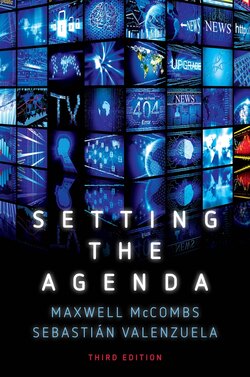Setting the Agenda

Реклама. ООО «ЛитРес», ИНН: 7719571260.
Оглавление
Maxwell McCombs. Setting the Agenda
Contents
Guide
Pages
Dedication
Setting the Agenda. The News Media and Public Opinion
Copyright page
Boxes
Foreword: ‘Messages and Residues’
Preface
Notes
1 Influencing Public Opinion
Our pictures of the world
Contemporary empirical evidence
The accumulated evidence
The 1972 US presidential election in Charlotte
The 1976 US presidential election in three communities
National concern about civil rights
British and American concern about foreign affairs
Public opinion in Germany
Agenda setting in a Swedish election
Public opinion in Louisville
Local public opinion in Spain, Japan, and Argentina
Replication with other issues
Cause and effect
A new communication landscape
1. Do online media have agenda-setting effects among the public?
2. Has the proliferation of online media diminished the agenda-setting impact of the traditional media?
3. To what extent are there specific channel effects vs. the collective impact of a communication gestalt?
Summing up
Notes
2 Reality and the News
Idiosyncratic pictures
A decade of American public opinion
Creating a crisis
National concern about drugs
Fear of crime
Discovering the environment
Alarmed discovery
Perspectives on agenda-setting effects
Content versus exposure
Agenda setting in past centuries
Summing up
Notes
3 The Pictures in our Heads
Pictures of political candidates
Candidate images in national elections
Candidate images in local elections
Visual images and attributes
Attributes of issues
Compelling arguments
Agenda setting and other communication theories
Attribute agenda setting and framing
Summing up
Notes
4 Networks of Issues and Attributes
Associative memory
Networks of candidates and attributes
Accumulated evidence on network agenda setting
A new gestalt perspective
Summing Up
Notes
5 Why Agenda Setting Occurs
Relevance and uncertainty
Occurrence of agenda-setting effects
Relevance
Personal experience with public issues
Individual differences
Incidental learning
Agenda-melding
Summing up
Notes
6 How Agenda Setting Works
Carrying capacity of the public agenda
Diversity and volatility of the public agenda
Education and agenda setting
Explaining the transfer of salience
Timeframe for effects
Diversity of salience measures
Summing up
Notes
7 Shaping the Media Agenda
The president and the national agenda
Subsidizing the media agenda
Capturing the media agenda
Three election agendas
Media agendas in local elections
Attributes of local issues
Three elements of elections
A broader portrait
Intermedia agenda setting
Summing up
Notes
8 Consequences of Agenda Setting
Priming public opinion
Attribute agendas and opinions
Forming opinions
Influencing behaviour
Agenda setting role of business news
Summing up
Notes
9 Communication and Society
Transmission of culture
New agenda-setting arenas
Other cultural agendas
Concepts, domains, and settings
Continuing evolution of agenda-setting theory
Notes
Bibliography
Index
POLITY END USER LICENSE AGREEMENT
Отрывок из книги
For Betsy
Maxwell McCombs
.....
All our examples of the agenda-setting influence of the news media examined to this point have been grounded in presidential elections or national portraits of public opinion. But there are also agenda-setting effects on local public issues. We begin with the long-term public opinion trends in an American city, trends that are analysed for the aggregate agenda, as well as separately for the eight individual issues on that agenda.22 When the trends in public opinion from 1974 through 1981 in Louisville were compared to the news coverage of the Louisville Times, the overall correlation between the public agenda and the news agenda was +0.65. Further analysis examined the ebb and flow of concern across these eight years for each of the eight issues. Significant agenda-setting effects were found for the top four issues on the news agenda: education, crime, the local environment, and local economic development.
Despite their influence on many issues, the news media are not all-powerful dictators of public opinion. The issues ranking fifth and sixth on the Louisville Times’ agenda – public recreation and health care, respectively – are examples of reverse agenda setting, a situation where public concern sets the media agenda. The lack of media omnipotence is also detailed in two other instances. Public concern about local government was independent of the trends in news coverage, despite the fact that local government is one of the traditional staples of daily newspaper coverage. Perhaps heavy continuing coverage of local government – or any other topic, for that matter – becomes a blur of white noise rather than a stream of information. Not only was public concern about local government immune to any agenda-setting influence of the press, the trend in news coverage was also immune to any reverse agenda setting, even though local government ranked sixth on the public agenda during those years.
.....